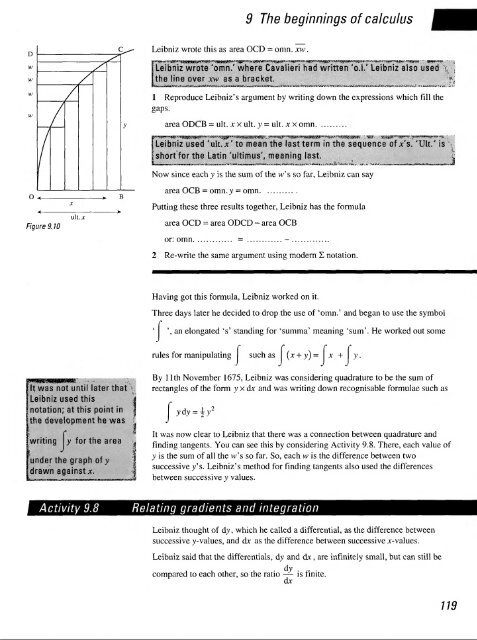history of mathematics - National STEM Centre
history of mathematics - National STEM Centre
history of mathematics - National STEM Centre
You also want an ePaper? Increase the reach of your titles
YUMPU automatically turns print PDFs into web optimized ePapers that Google loves.
Figure 9.10<br />
u\t.x<br />
It was not until later that<br />
Leibniz used this<br />
notation; at this point in<br />
the development he was<br />
f<br />
writing \y for the area<br />
under the graph <strong>of</strong> y ;i<br />
drawn against x. ;<br />
Leibniz wrote this as area OCD = omn. xw.<br />
9 The beginnings <strong>of</strong> calculus<br />
Leibniz wrote 'omn.' where Cavalieri had written '0.1,' Leibniz also used<br />
the line over xw as a bracket.<br />
1 Reproduce Leibniz's argument by writing down the expressions which fill the<br />
gaps.<br />
area ODCB = ult. x x ult. y = ult. x x omn. .........<br />
Leibniz used "ult. x' to mean the last term in the sequence <strong>of</strong> x's. 'Ult.' is<br />
short for the Latin 'ultimus', meaning last.<br />
Now since each y is the sum <strong>of</strong> the w's so far, Leibniz can say<br />
area OCB = omn. y = omn. ..........<br />
Putting these three results together, Leibniz has the formula<br />
area OCD = area ODCD - area OCB<br />
or: omn. ............ = ..........................<br />
2 Re-write the same argument using modern Z notation.<br />
Having got this formula, Leibniz worked on it.<br />
Three days later he decided to drop the use <strong>of</strong> 'omn.' and began to use the symbol<br />
', an elongated 's' standing for 'summa' meaning 'sum'. He worked out some<br />
f f f f<br />
rules for manipulating such as \ (x + y) = \ x + \ y .<br />
-/ J J m/<br />
By 1 1th November 1675, Leibniz was considering quadrature to be the sum <strong>of</strong><br />
rectangles <strong>of</strong> the form y x dx and was writing down recognisable formulae such as<br />
It was now clear to Leibniz that there was a connection between quadrature and<br />
finding tangents. You can see this by considering Activity 9.8. There, each value <strong>of</strong><br />
y is the sum <strong>of</strong> all the w's so far. So, each w is the difference between two<br />
successive /s. Leibniz's method for finding tangents also used the differences<br />
between successive y values.<br />
Activity 9.8 Relating gradients and integration<br />
Leibniz thought <strong>of</strong> Ay, which he called a differential, as the difference between<br />
successive y-values, and Ax as the difference between successive x-values.<br />
Leibniz said that the differentials, dy and dx, are infinitely small, but can still be<br />
dy<br />
compared to each other, so the ratio — is finite.<br />
dx<br />
119
















